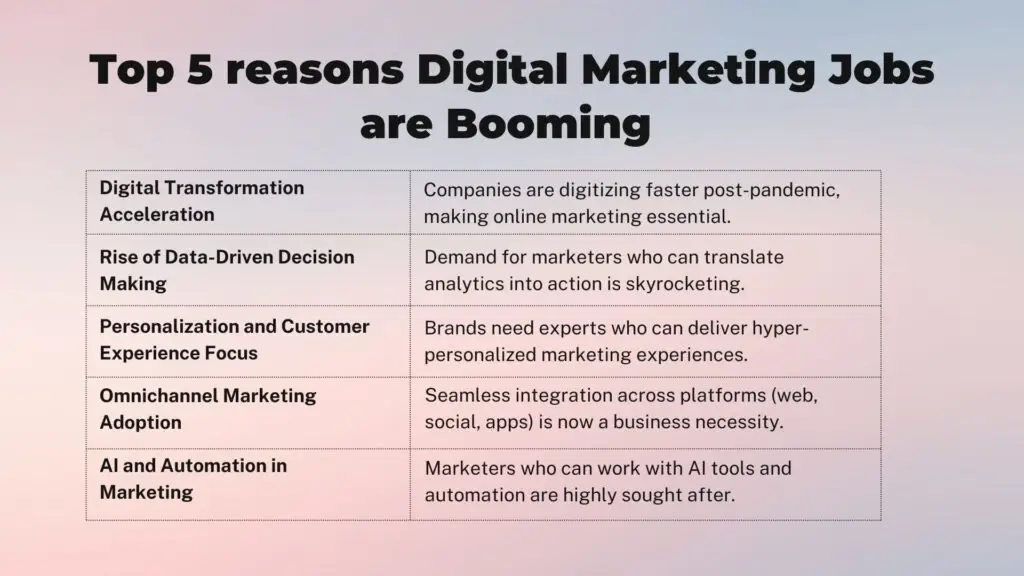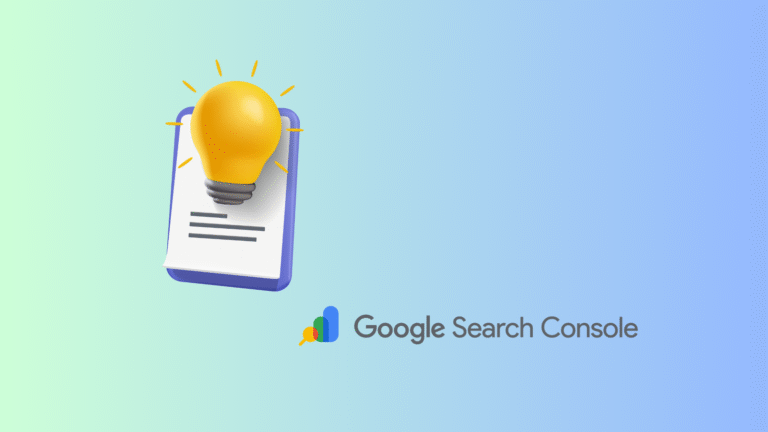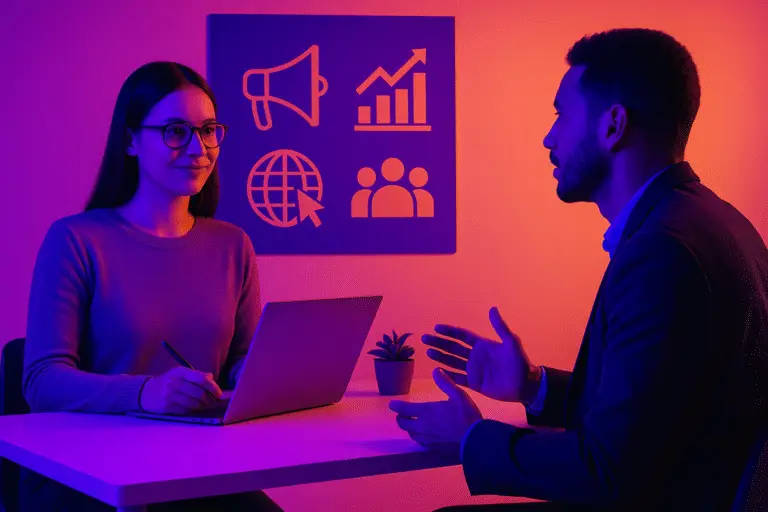The digital marketing landscape is evolving faster than ever, and in 2025, businesses are investing heavily in digital-first growth strategies. According to LinkedIn’s Global Talent Trends Report and HubSpot’s State of Marketing survey, demand for skilled digital marketers has risen by over 29% year-over-year, especially for roles specializing in SEO, content marketing, paid media, and data analytics. Companies aren’t just looking for “marketers” anymore—they’re seeking full-stack digital marketing experts who can drive measurable growth.
If you’re preparing for a job in this competitive market, know this: traditional interview preparation won’t cut it anymore. Simply memorizing definitions or textbook concepts isn’t enough. Today’s hiring managers want candidates who can think strategically, adapt quickly to changing platforms, and demonstrate real-world marketing impact with data to back it up.
That’s exactly where this guide comes in.
Welcome to the Digital Marketing Interview Guide 2025: 100 Questions with Winning Answers — your ultimate preparation companion. In this guide, you’ll find:
- Top 100 most frequently asked digital marketing interview questions updated for 2025 hiring trends.
- Winning answers with expert strategies, real-world examples, and practical insights.
- Scenario-based case studies to help you showcase knowledge and strategic thinking.
Whether you’re a fresher entering the marketing world, an experienced professional aiming for your next significant role, or someone transitioning into digital marketing from another career path, this guide is designed to equip you with everything you need to succeed.
According to LinkedIn’s 2025 hiring trends, recruiters’ roles are evolving, and hiring managers are taking on more responsibilities in the recruitment process.
Let’s dive in, prepare you to answer questions, and own the interview room.
Why Digital Marketing Skills Are In Demand in 2025
In a hyperconnected world where businesses live or die by their online presence, digital marketing skills are no longer optional—they’re mission-critical. As of 2025, industries are doubling down on digital channels, automation, data analytics, and personalized marketing strategies to stay competitive.
According to HubSpot’s 2025 Marketing Trends Report, 74% of global businesses have increased their digital marketing budgets compared to last year. LinkedIn reports a 33% surge in job postings for digital marketing roles. The digital economy isn’t just growing—it’s accelerating.

Top Industries Hiring Digital Marketers in 2025
Specific sectors are especially hungry for digital marketing talent. These include:
- eCommerce: Online brands scaling rapidly need acquisition and retention experts.
- SaaS (Software as a Service): SaaS companies heavily invest in content, paid ads, and inbound marketing.
- Healthcare & Wellness: Patient acquisition through digital channels is a growing priority.
- EdTech: Online learning platforms need aggressive digital strategies to stand out in a crowded space.
Future-Proof Digital Marketing Skills for 2025
To thrive in this evolving landscape, marketers need to master:
- SEO for AI-powered search engines (AI Overview, SGE)
- Advanced Paid Media Optimization (Meta, Google, Programmatic Ads)
- Content Strategy & Storytelling with Data
- Customer Journey Mapping and Funnel Building
- AI & Marketing Automation Tools (ChatGPT, Jasper, HubSpot AI)
As search shifts toward AI, mastering Answer Engine Optimization is key. Read this answer engine Optimization ( AEO) guide to stay visible in AI overviews, featured snippets, and chat-based results.
Developing these Digital Marketing Skills for 2025 will make you a more attractive candidate and position you as a future-ready marketing leader.
Building Genuine Connections
Of course, LinkedIn is not only about getting leads and increasing your follower count; it’s all about building a professional relationship.
Personalization reflects your efforts and the time you have spent understanding their profile, which makes them feel valued.
Honestly, who didn’t love that? Everyone appreciates the efforts, and a personal touch can distinguish you from countless others.
How to Prepare for a Digital Marketing Interview
Landing a digital marketing role in 2025 requires more than just theoretical knowledge—it requires showing real-world understanding, technical skills, and strategic thinking. Many candidates struggle not because they lack knowledge but because they fail to present it effectively.
Here’s how to strategically prepare for your upcoming interviews and stand out from the competition:
Research the Company’s Marketing Strategies
Before you step into any interview, deep-dive into the company’s digital footprint.
- Analyze their website SEO structure (use free tools like Ahrefs Webmaster Tools or Ubersuggest).
- Study their content marketing style—blogs, videos, social media.
- Identify which platforms they advertise on (Google Ads, Meta, LinkedIn, etc.).
- Review recent campaigns or PR activities and think about what worked (or didn’t).
✅ Pro Tip: Prepare 2–3 suggestions on how you would optimize or expand their current marketing efforts.
Optimize Your Personal Brand
Hiring managers will Google you. Make sure your brand reflects your skills:
- LinkedIn Profile:Update your headline, summary, and featured section with marketing projects, certifications, and measurable results. If you’re unsure how to reach out to new connections professionally, check out this quick guide on how to write a personalized connection request on LinkedIn — it can help you start valuable conversations before and after interviews.
- Portfolio: Create a clean, results-driven portfolio highlighting real or mock campaigns. Tools like Canva or Notion work great for this.
- GitHub for Marketers(Optional): If you have SEO scripts, automation bots, or analytics dashboards, hosting them on GitHub can impress technically inclined hiring managers.
✅ Pro Tip: Even if you’re a fresher, showcasing marketing certifications (Google Ads, HubSpot, Meta Blueprint) adds instant credibility.
Learn to Explain Campaign Case Studies and Project Results
Companies want marketers who deliver outcomes, not just “manage tasks.”
- Prepare 2–3 detailed case studies of campaigns you ran or contributed to.
- Frame your answers around the STAR Method (Situation, Task, Action, Result).
- Quantify your results (e.g., “Increased landing page conversion rate by 28% over 3 months”).
✅ Pro Tip: Highlight how you interpreted marketing data and turned insights into actions.
Practice Technical Concepts
Technical questions are inevitable, especially for mid-level and senior roles.
Focus on brushing up:
- SEO fundamentals: On-page SEO, link building, Core Web Vitals.
- Paid Media basics: Ad auction model, bidding strategies, CTR optimization.
- Analytics know-how: GA4 setup, event tracking, attribution models.
Mastering these Digital Marketing Interview Skills will boost your confidence and position you as a strategic marketer, not just a task executor.
Top 100 Digital Marketing Interview Questions and Winning Answers
Section A: Basic-Level Questions (Freshers)
If you’re starting in digital marketing, interviewers want to test whether you understand the fundamentals and key terms clearly.
Here are 25 basic-level questions and expert-mode answers to help you lay a strong foundation:
1. What is Digital Marketing?
Answer:
Digital marketing promotes products, services, or brands using digital channels such as websites, social media, search engines, email, and mobile apps. It focuses on reaching customers where they spend most of their time online using strategies like SEO, PPC, content marketing, and social media engagement.
2. What are the Top 7 Types of Digital Marketing?
Answer:
The 7 main types of digital marketing are:
- Search Engine Optimization (SEO)
- Pay-Per-Click Advertising (PPC)
- Content Marketing
- Social Media Marketing (SMM)
- Email Marketing
- Affiliate Marketing
- Mobile Marketing (SMS, apps, push notifications)
✅ Pro Tip: Companies today often expect marketers to combine 2–3 types into an integrated strategy.
3. What is SEO in Digital Marketing?
Answer:
SEO (Search Engine Optimization) improves a website’s visibility on search engines like Google. It involves optimizing content, website structure, and technical factors to rank higher organically in search results, thus attracting more relevant traffic without paid ads.
4. What does PPC mean?
Answer:
PPC stands for Pay-Per-Click, a type of digital advertising in which businesses pay a fee each time someone clicks their ad. Common platforms include Google Ads and Meta Ads. Compared to organic methods like SEO, PPC is a fast way to drive traffic.
5. What is SEM?
Answer:
SEM (Search Engine Marketing) refers to promoting websites through paid advertising (like Google Ads) and organic optimization (SEO). It’s a broad term that includes paid search (PPC) and organic search tactics.
6. What is a KPI in Digital Marketing?
Answer:
A KPI (Key Performance Indicator) is a measurable value that indicates how effectively a campaign achieves its objectives. Examples include website traffic, click-through rate (CTR), cost per lead (CPL), and customer acquisition cost (CAC).
7. What is CTR?
Answer:
A KPI (Key Performance Indicator) is a measurable value that indicates how effectively a campaign achieves its objectives. Examples include website traffic, click-through rate (CTR), cost per lead (CPL), and customer acquisition cost (CAC).

8. What is ROI in Digital Marketing?
Answer:
ROI (Return on Investment) measures the profitability of a marketing campaign. It’s the ratio of net profit to the campaign’s cost, expressed as a percentage. A positive ROI indicates that the campaign generated more revenue than it cost.
9. Why is Digital Marketing Important for Businesses Today?
Answer:
Digital marketing allows businesses to reach a global audience, target specific customer segments, track performance in real-time, personalize communication, and optimize costs compared to traditional marketing.
10. What is the Difference Between Inbound and Outbound Marketing?
Answer:
- Inbound Marketing: Attracts customers organically (SEO, content marketing, webinars).
- Outbound Marketing: Pushes messages to potential customers (cold calling, TV ads, display ads).
11. What are the Benefits of SEO?
Answer:
- Long-term, sustainable traffic
- Increased brand visibility
- Higher credibility and trust with users
- Cost-effective lead generation over time
12. What is Organic Traffic?
Answer:
Organic traffic refers to visitors who land on your site through unpaid search engine results rather than paid ads.
13. What are Backlinks?
Answer:
Backlinks are links from one website to another. They are critical for SEO because they act as votes of confidence, signaling to search engines that your content is credible and valuable.
14. What is a Landing Page?
Answer:
A landing page is designed specifically for a marketing or advertising campaign. Its goal is to encourage a specific action, such as filling out a form or purchasing.
15. What is a Buyer Persona?
Answer:
A buyer persona is a semi-fictional representation of your ideal customer, based on market research and real data about your existing customers. It helps marketers tailor messaging and strategies effectively.
16. What is the Difference Between SEO and SEM?
Answer:
- SEO: Organic efforts to rank higher in search results.
- SEM: Paid efforts (PPC) + organic SEO to increase visibility.
17. What is an Email Marketing Funnel?
Answer:
An email marketing funnel represents a subscriber’s journey from their first interaction (awareness) to becoming a loyal customer (conversion), driven by targeted and automated email sequences.
18. What are Impressions in Digital Marketing?
Answer:
Impressions measure how often your ad, page, or content is displayed, regardless of whether it was clicked.
19. What is Retargeting in Digital Marketing?
Answer:
Retargeting is an advertising technique that serves ads to users who have previously interacted with your website or content but didn’t convert.
20. What is a Call to Action (CTA)?
Answer:
A Call to Action is a prompt that encourages users to take a specific action, such as “Buy Now”, “Download Free Guide”, or “Sign Up Today.”
21. What is Conversion Rate?
Answer:
Conversion rate is the percentage of users who complete a desired action (purchase, sign-up, download) compared to the total number of visitors.
22. What is the Difference Between B2B and B2C Marketing?
Answer:
- B2B (Business-to-Business): Marketing aimed at businesses or organizations.
- B2C (Business-to-Consumer): Marketing aimed directly at individual consumers.
23. What is Content Marketing?
Answer:
Content marketing involves creating and distributing valuable, relevant, and consistent content to attract and retain a clearly defined audience—and ultimately, drive profitable customer action.
24. What is Influencer Marketing?
Answer:
Influencer marketing leverages individuals with large, engaged audiences (influencers) to promote products or services to their followers.
25. What is Mobile Marketing?
Answer:
Mobile marketing targets audiences on smartphones, tablets, and other mobile devices through SMS, mobile apps, push notifications, and responsive websites.
By mastering these basic digital marketing concepts, you build a strong foundation that interviewers expect every modern marketer to have in 2025.
Section B: Intermediate Questions (1–3 Years Experience)
Once you have 1–3 years of digital marketing experience, interviewers expect you to demonstrate strategic thinking, technical know-how, and the ability to deliver measurable results.
These questions go beyond theory — they test how well you apply marketing principles in real-world campaigns.
Here are a few intermediate-level questions and winning answers to prepare you for 2025 interviews:
26. How do you create a digital marketing strategy from scratch?
Answer:
Creating a strategy involves:
- Understanding the business goals: Start with the objective (brand awareness, lead generation, conversions).
- Researching the target audience: Create buyer personas using demographic and psychographic data.
- Channel selection: Choose platforms (SEO, social media, email, paid ads) based on where the audience is active.
- Setting KPIs: Define success metrics (e.g., CPL, ROAS, organic traffic growth).
- Budget planning: Allocate the budget based on channel ROI predictions.
- Execution and optimization: Launch, monitor, and continually optimize campaigns based on performance data.
✅ Pro Tip: Always align the marketing strategy to the customer journey stages: Awareness → Consideration → Decision.
27. Explain a successful campaign you managed and the key KPIs you tracked.
Answer:
“I led a paid search campaign for an e-commerce client targeting holiday shoppers. We achieved a 35% higher ROAS compared to the previous year.”
Key KPIs tracked:
- CTR (Click-Through Rate): To gauge ad relevancy.
- Conversion Rate: To measure landing page performance.
- Cost Per Acquisition (CPA): To optimize bidding strategies.
- Customer Lifetime Value (CLV): To evaluate long-term profitability.
28. How does content marketing drive conversions?
Answer:
Content marketing nurtures leads by providing valuable information and building trust over time. High-quality content:
- Positions the brand as an authority
- Solves customer pain points
- Guides users through the buying journey with blog posts, case studies, videos, and webinars
- Incorporates CTAs that encourage next-step actions like signups, downloads, or purchases
✅ Real-world example: A SaaS company increased demo signups by 42% after publishing educational blog posts paired with targeted lead magnets.
29. What metrics would you track for a brand awareness campaign?
Answer:
- Impressions
- Reach
- Engagement Rate (likes, shares, comments)
- Brand recall surveys
- Website traffic spikes
30. What is a marketing funnel?
Answer:
A marketing funnel represents the stages a customer goes through before making a purchase:
- Top of Funnel (Awareness): Blog posts, social media ads
- Middle of Funnel (Consideration): Email nurturing, webinars
- Bottom of Funnel (Conversion): Free trials, special offers
31. What is a Customer Journey Map?
Answer:
A visual representation of every customer experience with your brand, from first touchpoint to final purchase and beyond. It helps marketers personalize messaging and improve user experience at every stage.
32. What is an Attribution Model?
Answer:
An attribution model determines which marketing channels get credit for a conversion. Examples:
- First-click attribution
- Last-click attribution
- Linear attribution
- Data-driven attribution (GA4 recommended)
33. How do you approach competitor analysis?
Answer:
- Audit competitor websites (SEO, UX, CTAs)
- Analyze social media engagement and ad strategies
- Study backlink profiles using tools like Ahrefs or SEMrush
- Identify content gaps and positioning strategies.
34. What is Retention Marketing?
Answer:
Retention marketing engages existing customers to increase their lifetime value and loyalty. Tactics include email marketing, loyalty programs, and personalized offers.
35. What’s the importance of CRO (Conversion Rate Optimization)?
Answer:
CRO helps maximize the percentage of visitors who take a desired action without increasing ad spend. It involves optimizing landing pages, forms, CTAs, and overall UX.
36. What tools do you use for SEO analysis?
Answer:
- Google Search Console
- Ahrefs
- SEMrush
- Screaming Frog
- SurferSEO
37. How do you manage a paid advertising budget?
Answer:
- Set clear objectives and KPIs.
- Start with test campaigns to gather baseline data.
- Allocate budget dynamically based on channel performance (shift towards best ROAS channels).
- Regularly review spend and CPA.
38. How would you optimize a landing page for higher conversions?
Answer:
- Strong, benefit-driven headline
- Minimalistic design with clear CTA
- Fast loading speed (especially mobile)
- Trust badges and social proof (testimonials)
- A/B testing different versions
39. What is GA4, and how is it different from Universal Analytics?
Answer:
GA4 uses an event-based data model instead of sessions and pageviews, making it more flexible for cross-platform tracking and privacy-focused environments.
40. How do you approach keyword research for SEO?
Answer:
- Start with seed keywords
- Expand using tools like Ubersuggest, SEMrush, Ahrefs
- Focus on long-tail keywords for niche targeting.
- Analyze competition, intent, and search volume.
41. What’s the role of a CRM in digital marketing?
Answer:
CRM systems (like HubSpot or Salesforce) help marketers manage customer data, automate workflows, personalize messaging, and track lifecycle stages.
42. How do you handle negative comments on social media?
Answer:
- Respond professionally and promptly
- Apologize if necessary
- Offer to take conversations offline
- Monitor for patterns to improve brand perception.
43. What is Remarketing vs Retargeting?
Answer:
- Remarketing: Typically uses email to re-engage existing customers.
- Retargeting: Displays paid ads to people who visited your site but didn’t convert.
44. What is Domain Authority (DA)?
Answer:
A metric developed by Moz that predicts how well a website will rank on search engines, based on its backlink profile, age, and content quality.
45. How do you measure content performance?
Answer:
- Page views
- Time on page
Bounce rate - Engagement (comments, shares)
- Conversions driven by the content
46. How do you build an email subscriber list organically?
Answer:
- Lead magnets (ebooks, checklists)
- Exit-intent popups
- Blog CTAs
- Webinars and free events
47. What is a Lead Magnet?
Answer:
A free resource offered in exchange for a user’s contact information (e.g., downloadable PDF, free trial, exclusive webinar).
48. What’s the difference between an Impression and a Click?
Answer:
- Impression: Ad is displayed.
- Click: User actively interacts by clicking.
49. What is Programmatic Advertising?
Answer:
Automated buying and selling of online ad inventory in real-time via AI and algorithms, without manual negotiations.
50. How do you run a successful A/B Test?
Answer:
- Test one variable at a time (headline, image, CTA).
- Split your audience equally.
- Track statistically significant results before making decisions.
51. What is Geo-targeting?
Answer:
Serving different ads or content based on the user’s geographical location.
52. How do you choose between SEO and PPC?
Answer:
- SEO for long-term organic growth.
- PPC for immediate visibility and traffic.
✅ Smart strategy: Start PPC while SEO efforts mature.
53. How do you use storytelling in marketing?
Answer:
Stories create emotional connections that drive engagement and conversions. Good marketing stories highlight customer challenges, show transformation, and place the customer at the center.
54. What is User-Generated Content (UGC)?
Answer:
Content created by your customers’ reviews, testimonials, and photos increases authenticity and builds community trust.
55. How do you stay updated on digital marketing trends?
Answer:
- Follow credible blogs (HubSpot, Moz, Neil Patel)
- Attend webinars and conferences.
- Subscribe to marketing newsletters.
- Engage in online communities (GrowthHackers, LinkedIn groups)
At the intermediate level, interviewers want more than theoretical answers—they want strategic thinking, real results, and a strong understanding of campaign dynamics.
Section C: Advanced/Technical Digital Marketing Interview Questions (4+ Years Experience)
At the 4+ year experience level, technical skills, cross-channel management, and data-driven strategies are essential.
Interviewers expect you to understand digital marketing execution and optimize, automate, scale, and measure impact strategically.
Here are 30 advanced/technical digital marketing interview questions with in-depth answers, grouped into sub-sections for maximum clarity: SEO, Paid Ads, Social Media, Content Strategy, and Analytics.
🔵 SEO Questions
56. How would you optimize a website for Core Web Vitals?
Answer:
Focus on the three key metrics:
- Largest Contentful Paint (LCP): Optimize images, reduce server response time, and use lazy loading.
- First Input Delay (FID): Minimize JavaScript execution and use browser caching.
- Cumulative Layout Shift (CLS): Use fixed dimensions for images, reserve space for ads, and preload fonts.
✅ Example: I optimized an e-commerce site by compressing images (WebP format), implementing lazy loading, and improving server response, boosting LCP score by 40% within 2 months.
57. What is Structured Data, and why is it important for SEO?
Answer:
Structured data (schema markup) helps search engines better understand page content. It enhances rich snippets, improves CTR, and supports eligibility for Google’s AI Overview/Featured Snippets.
58. How do you recover a website from a Google penalty?
Answer:
- Identify the penalty (Manual vs. Algorithmic).
- Audit backlinks (remove toxic links).
- Improve content quality (E-E-A-T focus).
- Submit reconsideration request (for manual penalties).
59. What is E-E-A-T in SEO, and how do you implement it?
Answer:
Experience, Expertise, Authoritativeness, and Trustworthiness — you implement it by:
- Author bios, credentials, and case studies
- Citations to reputable sources
- Secure website (HTTPS)
- User-generated reviews and testimonials
60. What’s the role of a Content Delivery Network (CDN) in SEO?
Answer:
CDNs reduce latency by serving content from geographically closer servers, improving load times, and directly affecting Core Web Vitals and SEO ranking factors.
🟣 Paid Ads / PPC Questions
61. Explain Attribution Models and how they impact campaign evaluation.
Answer:
Attribution models determine how conversion credit is assigned across touchpoints.
- First-click: Credit goes to the first interaction.
- Last-click: Credit goes to the final interaction.
- Linear: Even distribution.
- Data-driven (GA4): AI assigns credit based on actual user behavior.
✅ Impact: Misaligned attribution can lead to wrong budget allocation and missed optimization opportunities.
62. How do you set up and optimize Performance Max campaigns in Google Ads?
Answer:
- Feed high-quality creative assets.
- Add audience signals for better machine learning targeting.
- Monitor asset group performance reports.
- Exclude low-performing placements manually via brand safety settings.
63. What’s your approach to scaling paid campaigns across multiple channels?
Answer:
- Test channels with pilot budgets (Google, Meta, LinkedIn, TikTok).
- Use UTM parameters and centralized attribution models.
- Retarget based on platform-specific engagement.
- Adjust creative per platform (no one-size-fits-all ads).
✅ Real-world example: I scaled a B2B SaaS paid funnel across Google Search, LinkedIn, and Meta, increasing lead volume by 70% in 6 months with cross-channel retargeting.
64. What is Programmatic Advertising, and how does it differ from traditional display ads?
Answer:
Programmatic uses real-time bidding (RTB) with AI and data to serve hyper-targeted ads dynamically, unlike manual placement with traditional display ads.
65. What metrics would you prioritize when optimizing paid search campaigns?
Answer:
- Quality Score
- Conversion Rate
- ROAS (Return on Ad Spend)
- Search Impression Share
- Cost Per Acquisition (CPA)
To prepare for PPC-related questions, Simplilearn offers a comprehensive list of Google Ads interview questions and answers that cover fundamental concepts and strategies.
Check out their blog –
70+ PPC and Google Adwords Interview Questions and Answers for 2025
🟡 Social Media Marketing (SMM) Questions
66. How do you build a full-funnel paid social strategy?
Answer:
- Top of Funnel: Awareness (Video views, reach campaigns)
- Middle of Funnel: Engagement, lead generation forms
Bottom of Funnel: Retargeting site visitors and engaged users with conversion-focused offers.
67. How would you optimize Facebook campaigns post iOS 14 privacy updates?
Answer:
- Verify domain
- Set up Aggregated Event Measurement
- Use broad targeting + CAPI (Conversions API)
- Focus on first-party data collection
68. How do you measure social media ROI?
Answer:
- Use UTM parameters to track conversions
- Attribute revenue to social campaigns (GA4 + CRM integration)
- Calculate ROI:

🔴 Content Strategy Questions
69. How would you run a Content Audit?
Answer:
- Inventory all content
- Analyze performance metrics (organic traffic, backlinks, conversions)
- Identify thin, outdated, or duplicate content
- Update, merge, or prune based on content ROI
70. How do you implement a topic cluster strategy for SEO?
Answer:
- Choose a core pillar page topic
- Create subtopic blogs that internally link to the pillar.
- Boosts topical authority and improves overall keyword rankings
71. How do you repurpose content across channels?
Answer:
- Blog → LinkedIn post → Email snippet → Instagram carousel → YouTube Shorts
- Tailor the message format while keeping the core value intact.
🟢 Analytics & Reporting Questions
72. How would you set up a GA4 property from scratch?
Answer:
- Create property → Setup data streams (Web/App) → Configure enhanced measurements.
- Define custom events (button clicks, form fills)
- Connect GA4 with Google Ads and Search Console
73. What are predictive audiences in GA4?
Answer:
Predictive audiences, powered by Google’s machine learning algorithms, automatically segment users based on their likelihood to purchase or churn.
74. How would you create a marketing dashboard for reporting?
Answer:
- Use Google Looker Studio (formerly Data Studio)
- Integrate sources (GA4, Ads, Social platforms)
- Automate weekly reporting
Focus on KPIs aligned to business goals (not vanity metrics)
75. What is Event Tracking, and why is it critical?
Answer:
Event tracking monitors user interactions (clicks, downloads, form submissions) beyond page views, essential for understanding behavior and optimizing conversion funnels.
🟠 Technical Deep-Dive Bonus Questions
76. How do you optimize a Shopify site for SEO?
Answer:
- Compress images
- Optimize product descriptions with keywords.
- Use clean, crawlable URL structures.
- Implement schema markup for the products.
77. How would you handle international SEO?
Answer:
- Use hreflang tags properly
- Separate country domains (.uk, .in) or subdirectories (/uk/, /in/)
- Localize content culturally, not just linguistically.
78. How can AI tools like ChatGPT or Jasper help digital marketing?
Answer:
- Draft first versions of ad copies, blog posts, and social media captions
- Summarize competitor analysis
- Speed up content brainstorming and research.
✅ However, Human editing is critical for brand tone and authority.
79. How do you conduct a technical SEO audit?
Answer:
- Crawl the website (Screaming Frog, Ahrefs)
- Analyze Core Web Vitals, mobile-friendliness
- Check broken links, duplicate content, and indexing issues.
Implement fixes systematically
80. What’s your approach to optimizing campaigns for Voice Search?
Answer:
- Focus on conversational, question-based keywords
- Optimize content for featured snippets.
- Improve page speed and mobile responsiveness.
At the senior level, your technical knowledge must extend beyond tactics. You must think across SEO, ads, content, social media, and analytics, backing your actions with precise data and business impact.
Scenario-Based and Case Study Questions (With Strategic Sample Answers)
Hiring managers in 2025 want marketers who can apply their skills in fast-paced, real-world environments. These scenario-based questions test your ability to think strategically, prioritize actions, and align marketing with business outcomes.
Here are 20+ practical scenario-based questions and sample answers to help you prepare like a pro:
81. Hypothetical: Your Google Ads campaign has a low CTR (<1%). What’s your immediate plan?
Answer:
- Step 1: Review the search terms report and identify irrelevant or low-intent keywords.
- Step 2: Rewrite ad copy using strong value propositions and dynamic keyword insertion.
- Step 3: Add ad extensions (sitelinks, callouts, structured snippets).
- Step 4: Split test 2–3 ad variations with different CTAs.
- Step 5: Tighten audience targeting or use in-market audience segments.
82. Scenario: You’re asked to increase organic traffic for a B2B SaaS product. Where do you start?
Answer:
- Audit existing content using Ahrefs and GA4.
- Identify keyword gaps in comparison to competitors.
- Develop a topic cluster strategy with a high-intent pillar page.
- Improve technical SEO (site speed, mobile optimization, Core Web Vitals).
- Start building backlinks via guest posts and PR mentions.
83. Real-World: What metrics would you prioritize for a seasonal e-commerce campaign?
Answer:
- Daily conversion rate
- ROAS (especially on Google/Meta Ads)
- Average order value (AOV)
- Cart abandonment rate
- Site speed and mobile usability
- Email open and click-through rates (for promos)
84. Hypothetical: Your landing page gets traffic but has low conversions. What now?
Answer:
- A/B test headline, CTA button color, and value proposition
- Reduce form fields
- Add trust signals (testimonials, security icons)
- Analyze scroll depth and heatmaps for drop-off points.
- Ensure fast loading (especially on mobile)
85. Scenario: A client’s blog isn’t ranking despite regular content updates. What do you recommend?
Answer:
- Review keyword targeting – are they using low-volume or irrelevant terms?
- Optimize internal linking structure.
- Add schema markup for articles.
- Build backlinks to blog pages (via guest posting or roundup inclusions)
- Improve content quality — focus on depth, data, and originality
86. Scenario: You’re managing a cross-platform ad campaign. How do you ensure consistent messaging?
Answer:
- Use a unified creative brief across all channels
- Tailor the messaging tone for each platform, keeping the core offer the same.
- Use a central UTM tracking framework.
- Align all campaigns under one CRM dashboard for unified reporting.
87. Hypothetical: Your email campaign open rate has dropped below 10%. What do you do?
Answer:
- Clean the list — remove inactive subscribers
- Personalize subject lines and test emojis/first names.
- Test send times and days.
- Warm up the domain if deliverability is suffering.
- Segment based on engagement and interests
88. Scenario: Your client asks for immediate traffic results. What’s your recommendation?
Answer:
- Launch a paid campaign targeting branded and high-intent keywords.
- Set up retargeting for all website visitors.
- Leverage influencer/affiliate collaborations for quick wins
- Email blast to re-engage warm leads
89. Hypothetical: You’re asked to improve the conversion rate of a lead-gen form. How do you approach it?
Answer:
- Reduce form fields to the absolute minimum
- Add social proof near the form.
- Move from above the fold.
- Use a progress bar if it’s multi-step
- Offer an incentive (e.g., free checklist or template)
90. Scenario: Management wants to shift focus from vanity metrics to real KPIs. What do you track?
Answer:
- CAC (Customer Acquisition Cost)
- MQL to SQL conversion rate
- CLTV (Customer Lifetime Value)
- ROAS (Return on Ad Spend)
- Assisted conversions
- Lead-to-close ratio
91. Hypothetical: A client has a tight budget and wants results fast. Where do you invest?
Answer:
- Google Search Ads on high-intent keywords
- Facebook lead generation campaigns
- Build one landing page optimized for conversion.
- Organic push via LinkedIn or Twitter with thought leadership content
92. Real-World: How would you organically scale an email list from 1K to 10K?
Answer:
- Create multiple lead magnets (guides, templates, free tools)
- Embed email capture forms in high-traffic blogs.
- Launch a referral program.
- Host webinars/workshops and capture registrations
- Partner with micro-influencers for co-branded giveaways
93. Scenario: Your campaign traffic is high, but the bounce rate is also high. What do you do?
Answer:
- Check page load speed
- Improve above-the-fold copy and visuals.
- Recheck targeting settings on ads
- Use session recordings to analyze behavior.
- Adjust landing page content for message match.
94. Hypothetical: The brand wants to start on TikTok. What’s your first step?
Answer:
- Research trends in your niche
- Identify 3–5 content formats that work (educational, storytelling, duets)
- Create a 30-day content calendar.
- Collaborate with micro-creators for early traction.
- Use captions + hooks in the first 3 seconds of video.
95. Scenario: You’ve been asked to justify the marketing budget to leadership. How do you do it?
Answer:
- Present performance trends are tied to revenue outcomes.
- Share channel-level ROAS or CPL.
- Forecast ROI from current pipeline metrics
- Benchmark against industry standards
- Propose reallocation from underperforming to high-performing channels.
Scenario-based questions are your chance to show strategic leadership and critical thinking. They allow you to go beyond definitions and prove that you can solve real business problems with marketing execution.
Strategic & Leadership-Level Digital Marketing Interview Questions
(Team Management, Learning, AI, Trends & Growth Mindset)
Because great marketers don’t just execute campaigns—they lead people, adapt to change, and stay ahead of the curve.
This section focuses on the soft and strategic aspects of digital marketing roles, which will become increasingly important in 2025, primarily as companies seek marketers who can lead, evolve, and stay relevant in a fast-changing ecosystem.
Below are 15 high-impact questions with interview-ready answers to help you demonstrate your leadership, learning agility, AI fluency, and strategic mindset.
96. How do you manage a digital marketing team with cross-functional responsibilities?
Answer:
- Start with clearly defined roles and KPIs for each team member.
- Use project management tools (e.g., Asana, ClickUp) for transparency and accountability.
- Host weekly syncs to align efforts across content, SEO, ads, and analytics.
- Foster open communication through Slack channels and async updates.
- Encourage ownership — not micromanagement — by tying tasks to business outcomes.
97. How do you ensure continuous learning within your team?
Answer:
- Allocate a fixed monthly time for upskilling (webinars, certifications, peer sessions).
- Share top marketing newsletters, trends, and updates weekly.
- Reward experimentation — create a “Fail Fast, Learn Faster” environment.
- Run monthly knowledge-sharing sessions led by team members.
98. What’s your approach to keeping up with marketing trends?
Answer:
- Subscribe to top-tier publications (Think with Google, HubSpot, Content Marketing Institute).
- Attend virtual summits and industry events quarterly.
- Follow practitioner voices on LinkedIn/Twitter over generic blogs.
- Maintain a personal swipe file of innovative campaigns.
99. How do you evaluate a new tool or AI platform for marketing use?
Answer:
- Define the use case (automation, content generation, reporting, etc.)
- Run a pilot test with a limited scope.
- Check for integration with the existing stack.
- Evaluate ROI vs. time saved.
- Consider data privacy and brand alignment.
100. What’s your philosophy on using AI in digital marketing?
Answer:
AI is a tool, not a replacement. I use it to:
- Speed up first drafts and ideation (e.g., ChatGPT, Jasper)
- Analyze data patterns faster.
- Automate low-value, repetitive tasks
However, the final strategy, messaging, and quality assurance remain human-led.
101. How do you prioritize campaigns when bandwidth or resources are limited?
Answer:
I use a “Quick Wins vs. Long-Term Impact” matrix:
- Prioritize high-ROI, low-effort activities
- Focus on the stages of the funnel most likely to convert.
- Eliminate non-essential tasks that don’t move the needle.
102. How do you handle team burnout in a fast-paced marketing environment?
Answer:
- Identify early signs (drop in creativity, missed deadlines)
- Set realistic campaign timelines.
- Encourage breaks, offline time, and “no-meeting” blocks.
- Be transparent — balance urgency with empathy.
103. Describe a time you had to convince leadership to approve an unconventional strategy.
Answer:
- Frame it in terms of data, not just opinion
- Share competitor case studies or emerging trends
- Propose a controlled test/pilot instead of a full rollout.
- Emphasize potential upside and limited downside risk.
104. How do you balance short-term performance marketing with long-term brand building?
Answer:
- Allocate 70% of the budget to performance (measurable ROI), 30% to brand (trust and visibility)
- Set different KPIs (ROAS vs. Engagement/Share of Voice)
- Tie brand marketing to future funnel performance (search lift, branded queries)
106. How would you coach a team member struggling with performance?
Answer:
- Have a 1:1 to understand roadblocks
- Set specific improvement goals and timelines.
- Pair them with a peer mentor.
- Provide feedback with empathy and clarity.
- Track progress and recognize wins.
107. How do you handle a campaign that underperforms despite proper execution?
Answer:
- Step back and revisit assumptions (audience, timing, messaging)
- Analyze every stage of the funnel for bottlenecks.
- Gather qualitative feedback from users.
- Communicate learnings with the team — treat it as a growth opportunity.
108. What do you believe makes a strong digital marketing leader in 2025?
Answer:
- Adaptability: Navigating AI and algorithm changes
- Empathy: Leading teams in hybrid, pressure-filled environments
- Data Literacy: Making confident decisions
Storytelling: Communicating impact internally and externally
109. How do you align your marketing team with sales or product teams?
Answer:
- Run regular joint meetings to sync goals
- Share pipeline data and insights.
- Build shared dashboards
- Ensure marketing content supports sales objections and product launches.
110. How do you approach mentorship and growing future marketing leaders?
Answer:
- Let junior marketers lead small projects
- Provide actionable feedback, not just reviews.
- Share industry contacts, tools, and knowledge.
- Encourage self-reflection and personal branding.
In 2025, marketers who lead with curiosity, clarity, and compassion are the ones who thrive. These questions help you showcase your strategic mindset, people skills, and ability to grow yourself and others in a fast-moving landscape.
Up next, we’ll uncover the top mistakes candidates make in interviews — and how you can avoid them.
Mistakes Candidates Must Avoid in 2025 Digital Marketing Interviews
Even experienced marketers can stumble in interviews, falling into common traps that undermine their credibility. In 2025, interviewers will evaluate your knowledge and ability to adapt, think critically, and contribute to real business growth.
Avoid these common pitfalls to stay ahead of the curve:
Mistake 1. Using Outdated Strategies
One of the fastest ways to lose credibility is referencing obsolete tools or tactics.
If you’re still talking about Universal Analytics instead of GA4, or prioritizing keyword stuffing and exact-match domains, you signal a lack of current industry awareness.
✅ Pro Tip: Mention how you’ve adapted to Google’s evolving search features (AI Overview, Core Web Vitals, etc.) and privacy-first platforms.
Mistake 2. Over-Focusing on Tactics Without Understanding Strategy
Saying you “ran Facebook ads” isn’t enough. Interviewers want to know:
- Why that platform?
- What part of the funnel did it target?
- How did it align with business goals?
Marketers who understand when and why to execute, not just how, stand out as strategic thinkers.
Mistake 3. Failing to Demonstrate Results Through Real Metrics
Saying “the campaign performed well” is vague.
Hiring managers want data-backed results:
- “We reduced CPL by 22% in Q1 through retargeting.”
- “Landing page conversion rate improved from 2.1% to 3.6% after A/B testing.”
✅ Pro Tip: Prepare 2–3 quantifiable achievements using clear KPIs.
Mistake 4. Being Unable to Explain Cross-Channel Campaign Impact
In today’s multi-platform world, marketing doesn’t live in silos.
Suppose you can’t explain how your SEO, ads, content, and email campaigns worked together to move prospects through the funnel. In that case, you risk sounding like a one-dimensional executor, not a growth-focused marketer.
✅ Be ready to map a campaign’s journey across touchpoints (e.g., ad → landing page → email sequence → purchase).
Digital marketing in 2025 requires more than execution; it demands adaptability, strategic insight, and results-driven thinking. Avoiding these mistakes helps you position yourself as a confident, future-ready marketer, not just another applicant.
Next up, we’ll wrap up your preparation journey and offer you exclusive tools to win your next interview.
Your Path to Digital Marketing Success in 2025
Preparing for a digital marketing interview in 2025 is no longer about memorizing buzzwords or rehearsing templated answers. It’s about showing you can think strategically, execute efficiently, and drive measurable business outcomes across multiple platforms.
Let’s quickly recap what separates successful candidates from the rest:
- You researched the company’s ecosystem, not just the role.
- You built a strong personal brand, not just a polished resume.
- You are prepared for real-world scenarios, not just textbook questions.
- You aligned your answers with results, relevance, and reasoning.
In 2025, marketing is not just about skills; it’s about how you communicate your impact. Interviewers seek marketers who blend technical expertise, creativity, and business acumen into one compelling story.
Whether you’re a fresher trying to break in or a seasoned professional aiming for leadership roles, your ability to connect the dots across SEO, content, paid media, analytics, and team strategy will set you apart.
In 2025, marketers who combine technical expertise with storytelling and results will win.

Mayank Ranjan
Mayank Ranjan is a digital marketing strategist and content creator with a strong passion for writing and simplifying complex ideas. With 7+ years of experience, he blends AI-powered tools with smart content marketing strategies to help brands grow faster and smarter.
Known for turning ideas into actionable frameworks, Mayank writes about AI in marketing, content systems, and personal branding on his blog, ranjanmayank.in, where he empowers professionals and creators to build meaningful digital presence through words that work.












